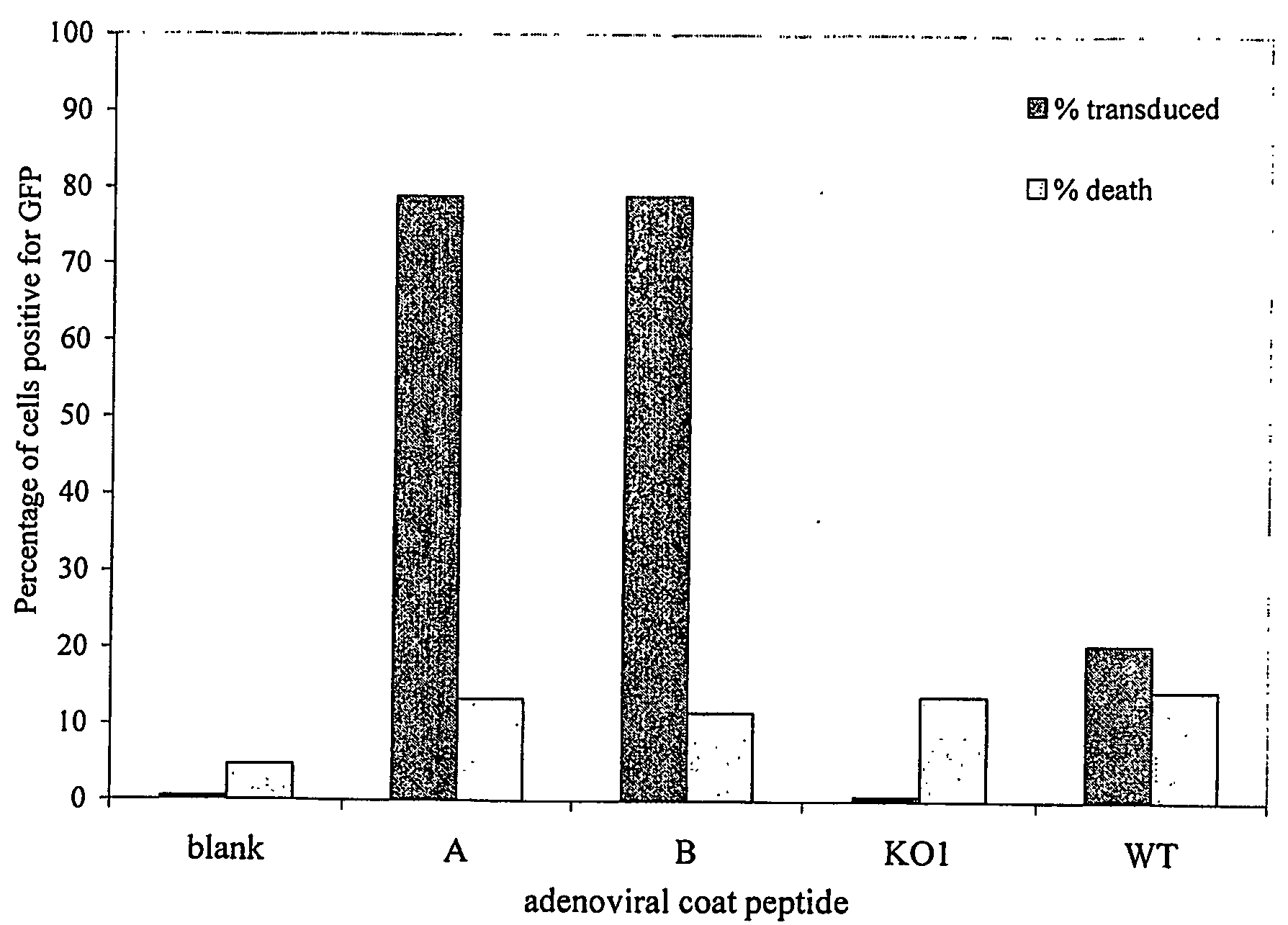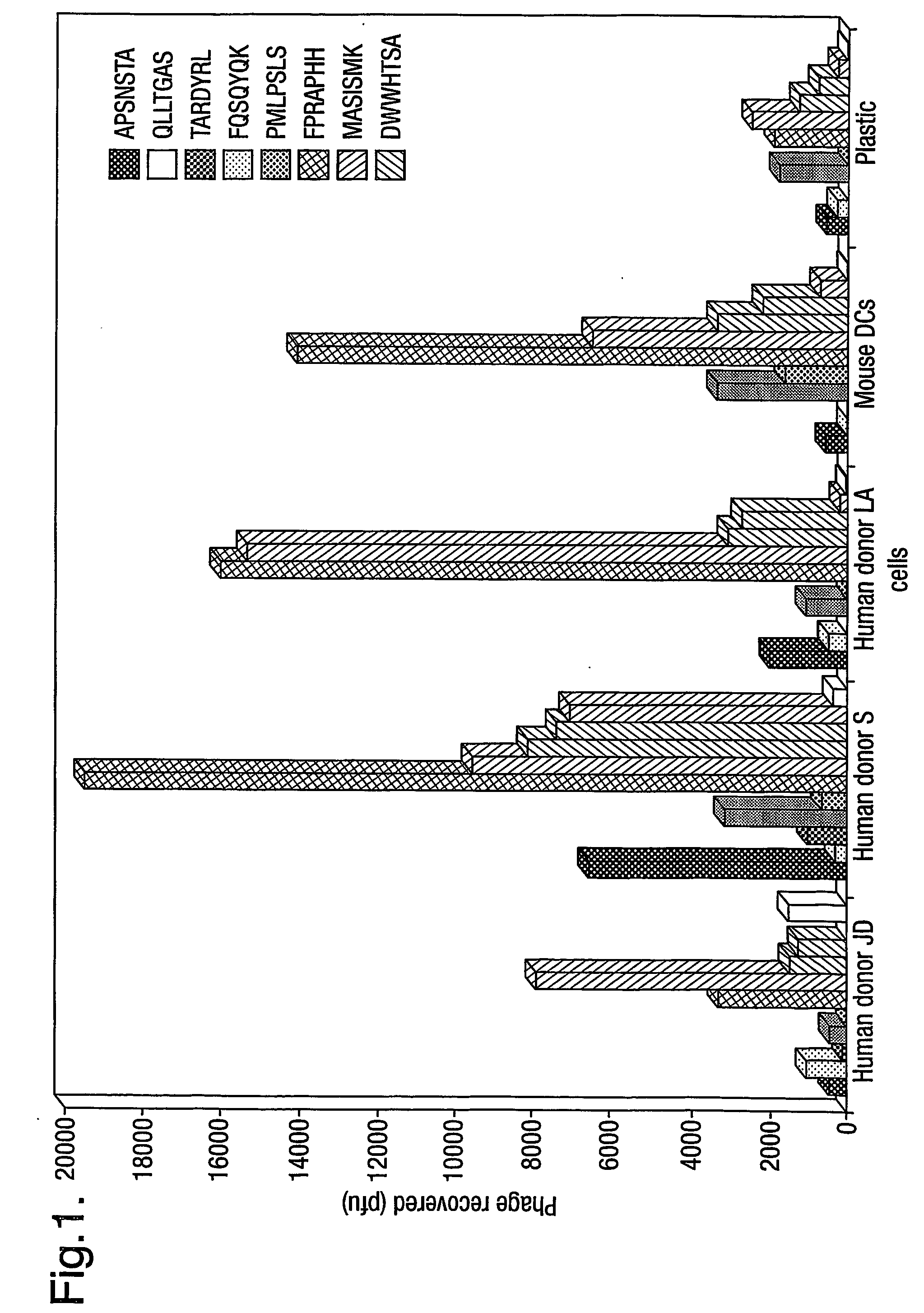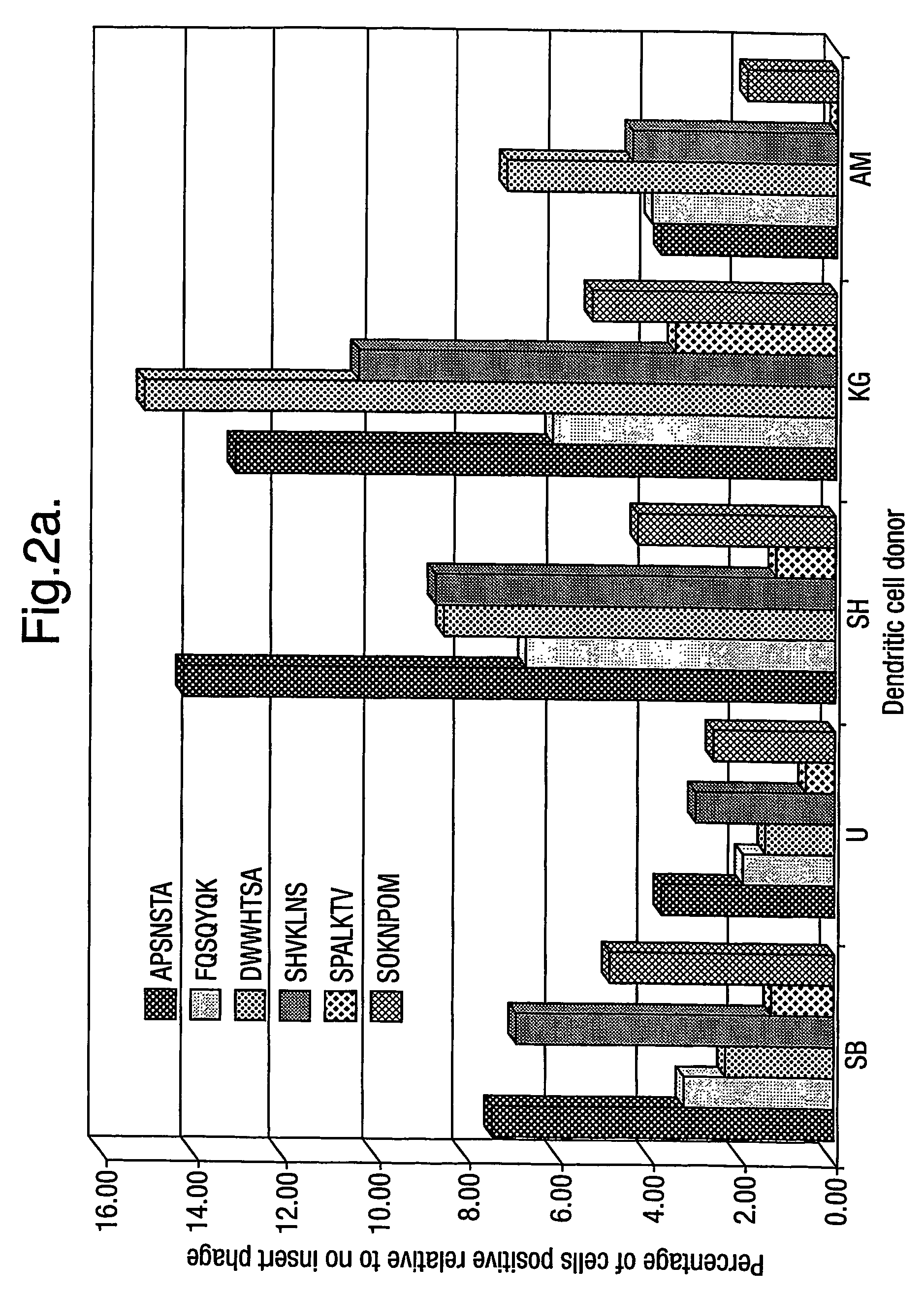Peptide ligands
a technology of peptides and ligands, applied in the field of peptide ligands, can solve the problems of inability to transfer sufficient inability to predict effective effect, and inability to transfer enough nucleic acid to specific target cells
- Summary
- Abstract
- Description
- Claims
- Application Information
AI Technical Summary
Benefits of technology
Problems solved by technology
Method used
Image
Examples
example 1
Identification of Peptide Motifs
Materials and Methods
(i) Antibodies
[0267]The following anti-human antibodies were used for flow cytometry: HLA-DR, CD40, CD86, and mouse IgG1 and IgG2 fluorescent isotype control antibodies (Beckton Dickinson UK Ltd, Cowley, UK) and CD80 and CD83 (Caltag Medsystems Lts, Towcester, UK), all of which were labelled with phycoerythrin (PE).
(ii) Cell Lines
[0268]The following cells lines were used HMEC-1 cells (CDC, Atlanta, Ga. 30333, U.S.A.), HAEo-cells (courtesy DC Gruenert, Human Molecular Genetics Unit, Department of Medicine, University of Vermont, Burlington, VT 05405, USA), Neuro-2a cells, also known as N2a cells (LGC Promochem, Teddington, Middlesex, UK), and HepG2 cells.
[0269]The human airway epithelial cell line (1HAEo-) was maintained in Eagle's Minimal Essential Medium (MEM) HEPES modification (Sigma, Poole, U.K.) supplemented with 10% foetal calf serum (FCS, Sigma, Poole, U.K.), 100 U / ml penicillin and 100 μg / ml streptomycin (InVitrogen, Paisl...
example 2
Non-Viral Transfection
Materials and Methods
(i) Peptide Synthesis
[0295]Peptides A, B, C, D and F (see Table 7), identified from phage that display desirable cell binding and entry characteristics, see Example 1, were synthesised using standard synthetic chemistry with a sixteen-lysine tail, a GAC linker, and a C-terminal CG group. Peptide 6, RRETEWA, is an integrin-binding peptide. Peptide 6J, ATRWARE, is a scrambled version of peptide 6, and serves as a control peptide. The term “peptide derivative” is used to denote the synthesized peptide sequence shown below i.e. “peptide A” denotes SHVKLNS and “peptide A derivative” denotes [K]16-GACSHVKLNSCG. Details of the peptides and peptide derivatives are given in Table 5 below.
TABLE 5Peptides and peptide derivativesPeptidenamePeptide sequencePeptide derivative sequenceASHVKLNS[K]16-GACSHVKLNSCGBAPSNSTA[K]16-GACAPSNSTACGCMASISMK[K]16-GACMASISMKCGDFPRAPHH[K]16-GACFPRAPHHCGFDWWHTSA[K]16-GACDWWHTSACG6RRETAWA[K]16-GACRRETAWACG6J[K]16-GACATRWAR...
example 3
Retargeting Adenovirus
Materials and Methods
(i) Mouse Bone Marrow Derived Dendritic Cells
[0320]Mouse dendritic cells were prepared from whole bone marrow flushed from the marrow cavities of the femur and tibia of 5-7 week old A / J mice and cultured in Hepes buffered RPMI+Glutamax (InVitrogen, Paisley, U. K.) supplemented with 10% FCS, penicillin / streptomycin and 20 ng / ml recombinant GM-CSF. Cytokines were added to the same concentration on day 3 and the dendritic cells isolated from the floating cell fraction by MACs CD11c microbeads (Miltenyi Biotec, Bisley, U. K.) on day 6.
(ii) Mouse Sca1+ve Stem Cells
[0321]Mouse bone marrow cells were isolated as above and Sca1+ve cells were isolated using MACs Sca1 microbeads (Miltenyi Biotec, Bisley, U.K.). These cells were plated at 7×104 cells / 500 □l in RPMI with Glutamax-1 containing 30% FCS and penicillin / streptomycin and the following cytokines murine SCF (50 ng / ml; Preprotech, London, UK), IL-6 (20 ng / ml; Preprotech, London, UK) and Flt3-L ...
PUM
| Property | Measurement | Unit |
|---|---|---|
| Length | aaaaa | aaaaa |
| Therapeutic | aaaaa | aaaaa |
| Nucleic acid sequence | aaaaa | aaaaa |
Abstract
Description
Claims
Application Information
 Login to View More
Login to View More - R&D
- Intellectual Property
- Life Sciences
- Materials
- Tech Scout
- Unparalleled Data Quality
- Higher Quality Content
- 60% Fewer Hallucinations
Browse by: Latest US Patents, China's latest patents, Technical Efficacy Thesaurus, Application Domain, Technology Topic, Popular Technical Reports.
© 2025 PatSnap. All rights reserved.Legal|Privacy policy|Modern Slavery Act Transparency Statement|Sitemap|About US| Contact US: help@patsnap.com



